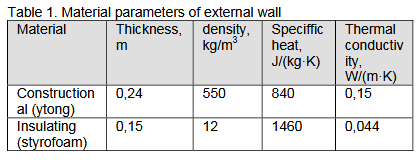ABSTRACT:
The article deals with energy consumption and efficiency problems in electrical underfloor heating applications. Influence of structural elements of electrically heated building, defined by different time constants, on operating characteristics of heating system were discussed.
Significant differences between temperature and energetic controllers were shown, especially in respect of variable climatic conditions and possibility to use of G12 tariff. Utility of calculation results, presented in the article can be a significant factor that enable to rational construction of multi-circuit underfloor heating systems and control algorithms.
AVERAGE ENERGY CONSUMPTION
In the article a typical storey building was analyzed. All walls were made from aerated concrete and insulated with styro foam. The attic was insulated with mineral wool. Total surface of windows and doors was at 15% of all walls surface.Thermal resistances were calculated for every part of the building and were used to determine heat loses related to minimal, average and maximal temperatures that were averaged for a month.

Operating Times of Underfloor Heating Systems with Single- and Two Heating Circuits for Monthly Averaged Temperatures.
MODELING OF HEATING PROCESS
Energetic parameters presented in previous section of the article were determined basing on extreme heat fluxes that were noticed in steady states. In real exploitation conditions of warming systems, energy consumption strongly depends on thermal delay time of building, especially of elements characterized by maximal heat capacitances. External walls and heating floor are characterized by described parameters.
EXEMPLARY POWER CONTROL MANNER
The time required for increase temperature of 15cm thick heating floor of 1K is from 100 to 300 minutes. In practice, cooling times are few times longer. So that, heating floor is the element characterized by asymmetric time constants. This feature is very often used in “casual” warming techniques.
The results of numerical analysis, temperature characteristics of heating floor temperature, have been shown in figure 10. In the first case, oscillations of floor temperature t1 have amplitude 2,3°C and in second case – 1,4°C. Lower temperature differences show that optimal case is utility of two-circuit underfloor heating system.
CONCLUSIONS
In the article basic problems of rational construction and exploitation of different types of underfloor heating systems were analyzed. Transient temperature analysis of basic constructional elements of exemplary building were presented. Two basic cases with single and two-circuits heating systems were compared in one-and two tariff systems. Different heating and cooling times of heating floor result from daily environmental conditions and maximal temperature of the floor.
Comparison between results enable to determine the energetic efficiency of all analyzed cases and to determine most important parameters that have a strong influence on control systems in such class of electrothermal objects. Presented results enable additionally to determine some constructional conditions of two-circuit floor heaters.It was shown that different time constant values of constructional elements and requirements related to thermal comfort, are factors which determine potential better parameters of two-circuit underfloor heating systems.
Possibility of precisely and independent control of heating process in all zones enable to control the accumulative energy and decrease the energy consumption of multi-circuit underfloor heating systems. In such class of electrothermal devices temperature controllers should be replaced with energy controllers with possibility of dynamic reaction to the changes in environmental conditions.
Source:
Authors: Politechnika Warszawska | Instytut Elektroenergetyki

